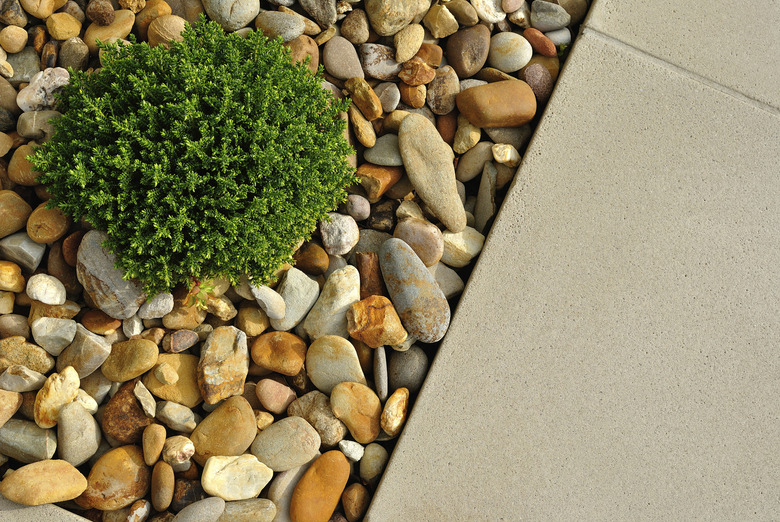How To Spray Thompson's Water Seal On Landscape Rock
We may receive a commission on purchases made from links.
Spraying Thompson's WaterSeal on landscape rock can give the stones a perpetually wet, shiny surface. This makes them look clean throughout the season, but you'll get even better results if you ensure the rocks are truly clean before beginning. Thompson's WaterSeal can also protect the rocks from premature weathering and fading due to UV light exposure, rainfall and abrasion from dirt and debris. Finally, spraying Thompson's WaterSeal on smaller sized landscape rocks can essentially glue them together, which prevents digging critters or heavy rains from disturbing the scenery.
Clean Rocks and Prepare Area
Clean Rocks and Prepare Area
Make sure the area looks as nice as possible before spraying Thompson's WaterSeal. The sealant will adhere better to the landscape rock if it's clean. Rake, sweep or blow away as much loose debris as possible, then tackle the surface stains and dirt.
Large stones can be scrubbed with a stiff-bristle brush dipped in a solution of water and dish soap or water and vinegar. You can also use a pressure washer if desired. Small stones may need to soak in warm, soapy water for best results. Rinse rocks with clean water and allow them to dry thoroughly before applying Thompson's WaterSeal.
Sanding is another way to clear away the dirty, faded layer of a rock to reveal a prettier, cleaner surface. Start with a coarse grit and work your way to a finer-grit sandpaper.
Choose the Right Day
Choose the Right Day
Thompson's WaterSeal is temperature-sensitive. Because it will become sticky if temperatures dip below 40 degrees Fahrenheit within 48 hours after application, the manufacturer recommends spraying only when the surface temperature of the rocks — and the air temperature — is above 50 degrees Fahrenheit both day and night.
They also advise against spraying Thompson's WaterSeal if rain is forecast within 24 hours after application. Spraying on a quiet day with no wind will also reduce the chance of accidentally spraying adjacent plants or structures. Cover these if needed, or immediately rinse them with water to remove the sealant.
Spray Thompson's WaterSeal
Spray Thompson's WaterSeal
Thompson's WaterSeal can be added to a pump-action garden sprayer for efficient application. Don't thin it with water or mix it with any other product. For small projects or touch-ups, Thompson's WaterSeal comes in an aerosol can, and the application instructions are essentially the same, minus the need to load it in a sprayer. Shake the can or sprayer well before use, and hold the nozzle about 12 inches from the landscape rocks while spraying a thin layer.
Over-saturating with this product won't help it perform better. It will, in fact, become oily and sticky. One layer is often all that's needed to produce the desired waterproofing effect. Allow this layer to dry for 24 hours, then drop some water on the rocks to see whether a second layer is necessary. If the water beads up and there's no absorption, you're good to go.
Thompson's WaterSeal will look milky-white when first applied, which will help you see where you've already sprayed — but it will dry clear. If the product puddles up, use a paintbrush to redistribute the excess liquid, or simply wipe it up with a paper towel . Wear gloves and eye protection to avoid irritation from this product, and use it only outside in a well-ventilated area.
